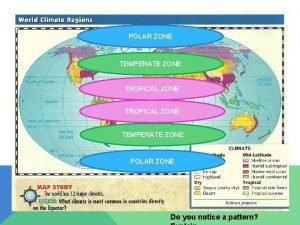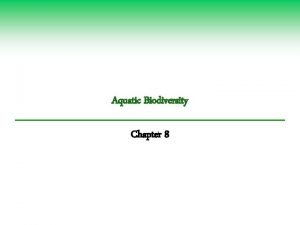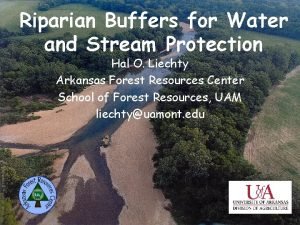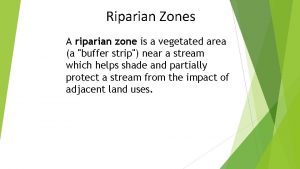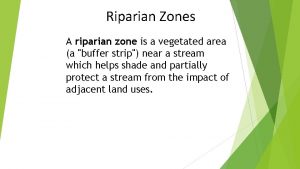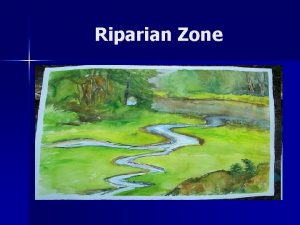Riparian Zones A riparian zone is a vegetated









- Slides: 9

Riparian Zones A riparian zone is a vegetated area (a "buffer strip") near a stream which helps shade and partially protect a stream from the impact of adjacent land uses.

In a healthy riparian zone, there are typically three layers of vegetation that occur: § Tall trees § Shorter trees and shrubs § Flowering plants and ferns

Zone 1. Large Native trees provide shade and bank stabilization Zone 2. Native shrubs, this zone provides habitat for wildlife. Absorbs contaminants. Zone 3. First line of defense against contaminants. Mostly of native grasses; slows water runoff. • Streambed Zone. Fallen limbs, trees, and tree roots; slows water flow, reduces erosion. Woody debris increases habitat and cover aquatic species.

Riparian zones are important to a stream because: • They filter pollutants and prevent them from entering the stream • They prevent the streambank from eroding or wearing away. • They supply shade to the stream Shade helps keep the water temperature cool. • They provide shelter and food for animals that live in or near the stream

Riparian Zone Environmental Benefits Water Quality • Intercepting sediment/ nutrients from fertilizers • Intercepting pesticides and other materials in surface runoff • Bank stabilization Habitat benefits • • Provide habitat Increase biodiversity Buffers acting as wildlife corridors Shading water

Riparian Zone Environmental Benefits Economic benefits • Increase land value • Produce profitable alternative crops – nut crops • Increase lease fees for hunting

Native Riparian Plants Cattails Edge Plants Blue Lobelia Swamp Mallow Button Bush Sedges Trees “water-loving” species Box Elder or Ashleaf Maple Silver Maple Sycamore Cardinal Flower Virginia Bell Flower Willows Buckeye Cottonwood Elms Swamp Milkweed Spice bush

Riparian Invasive Plants – introduced plants that replace natives – often the predominant plants found in riparian zones Japanese Knotweed Bush Honeysuckle Winter creeper Multiflora Rose Periwinkle Japanese Honeysuckle Air Yam English Ivy Burning Bush Garlic Mustard

Questions to consider: Why are native species more desirable than invasive species in riparian zones? What can be done to remove invasive species from riparian zones? What can be done to increase public awareness of the necessity of riparian zones along streams?
 How do littoral zones differ from riparian zones?
How do littoral zones differ from riparian zones? Tropical temperate and polar
Tropical temperate and polar Intertidal ocean zone
Intertidal ocean zone Source zone transition zone and floodplain zone
Source zone transition zone and floodplain zone Riparian zone
Riparian zone Crash course kids weather
Crash course kids weather Zone froide zone chaude magasin
Zone froide zone chaude magasin Photic zone and aphotic zone venn diagram
Photic zone and aphotic zone venn diagram Zone of aeration and zone of saturation
Zone of aeration and zone of saturation Minute ventilation normal
Minute ventilation normal

